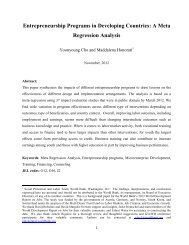Download - Youth Economic Opportunities
Download - Youth Economic Opportunities
Download - Youth Economic Opportunities
You also want an ePaper? Increase the reach of your titles
YUMPU automatically turns print PDFs into web optimized ePapers that Google loves.
Who Teaches Us Most About Financial Programing in Africa<br />
on unfamiliar pathways. The childhood imprints of poverty, poor health, bereavement,<br />
and unpredictability were uppermost in their lives; we recognized that technical<br />
details would be irrelevant and invalid unless the program’s design addressed,<br />
first and foremost, the psychological barriers.<br />
THE SEED MONEY PROGRAM<br />
The Seed Money Program (SMP) resulted from our consultation with young<br />
women. It was launched in Zimbabwe in 1999 and later introduced in Ghana,<br />
Zambia, and Tanzania. To date, the program has enabled 8,362 young women in<br />
these four countries to set up their own businesses. It is being introduced in<br />
Malawi in 2013. The design, which has remained broadly consistent, is based on<br />
the following premises:<br />
That a school graduate with negligible money experience does not have the<br />
understanding or confidence to enable her to take on a loan<br />
That safe livelihoods should be created in rural environments to enable young<br />
women to help build the rural economy<br />
That the friendship network these women established at school can foster business<br />
relationships in rural areas<br />
That the experiences of the client group as they establish and grow their businesses<br />
will be of huge value to later groups of school graduates, whom they reach<br />
through volunteer mentoring<br />
The SMP operates in areas where there are no financial services. Businesses<br />
run on cash transactions, and the protection of accumulated cash is imperative.<br />
One of the early lessons (borne out through subsequent years) was the distinction<br />
between financial exclusion and financial literacy; the fact that the young women<br />
had no money and had negligible experience using it did not mean they lacked an<br />
understanding of money. Financial intelligence among this client group was considerable,<br />
precisely because their poverty demanded that they achieve the highest<br />
level of security possible with the little cash available to the family. For example, the<br />
cost of goods and services the family requires was known to the last cent, including<br />
seasonal variations. The earnings of a family member living away from home<br />
were understood as a family asset that can be relied on for emergencies. However,<br />
negativity frames this financial literacy: far from being a neutral commodity offering<br />
choice and opportunity, money carries negative emotional baggage. Above all,<br />
years of living in poverty and witnessing parental stress around money means that<br />
each client’s relationship with money is suffused with anxiety and fear. The journey<br />
each woman took with the SMP had to be experiential and to include psychological<br />
and behavioral learning, as well as teaching financial and business skills.<br />
The program grew over the next decade and was offered to every girl who benefited<br />
from Camfed’s secondary school program. The social system around each<br />
woman provided peer mentoring that enhanced her formal training. In the early<br />
years, Camfed provided each participant with a cash transfer of $10 to $15—in the<br />
form of a grant, not a loan (the amount now has a ceiling of $100). The women had<br />
innovations / 2013 Global <strong>Youth</strong> <strong>Economic</strong> <strong>Opportunities</strong> Conference 229

















